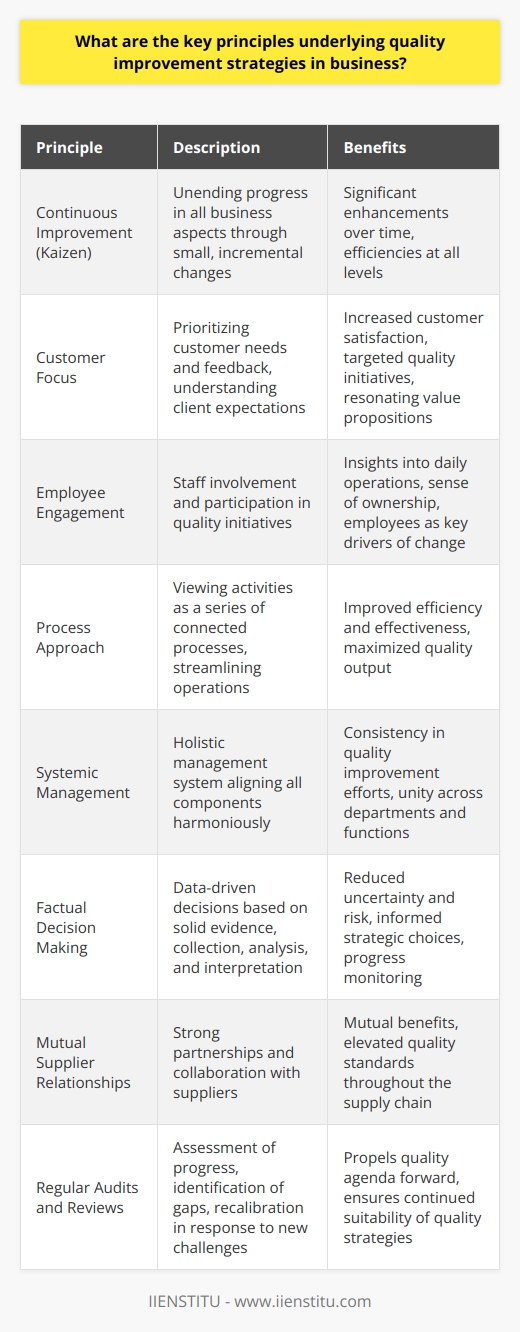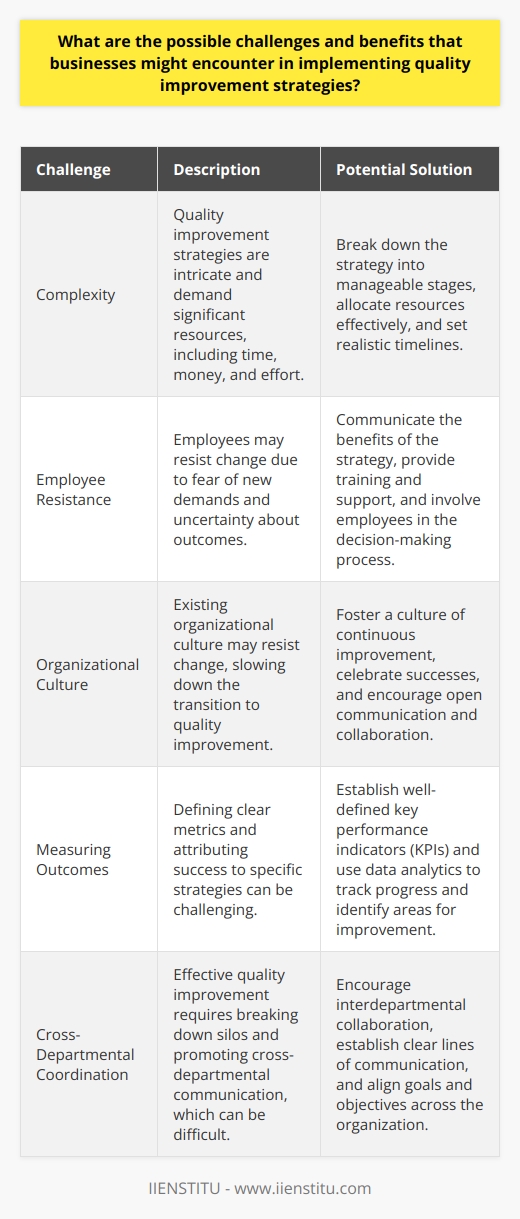
In an ever-evolving business landscape, maintaining a competitive edge necessitates a relentless focus on quality improvement. This blog post is dedicated to exploring the dynamic realm of Quality Improvement (QI), shedding light on its foundational strategies, principles, and the profound impact it can wield on business success. With businesses continually vying for differentiation in product offerings and service delivery, Quality Improvement emerges as a pivotal instrument for growth and customer satisfaction.
Understanding Quality Improvement
Definition of Quality Improvement
Quality Improvement is a systematic, data-guided approach to enhancing the quality of products and services. Academic circles often define QI as a methodological process that is continuous, based on specific measurements, and aimed at achieving improvements in various operational facets. In the real world, such definitions translate into a relentless pursuit of excellence, where organizations strive for not just meeting, but exceeding, the expectations of their customers.
The Importance of Quality Improvement in Businesses
At the heart of successful businesses is the undying commitment to Quality Improvement. Implementing QI strategies effectively means creating a value proposition that distinguishes an enterprise in the marketplace. Improvements in services or products can lead to a domino effect: increased customer satisfaction, enhanced reputation, and subsequently, a more profitable and sustainable business model.
Key Components of Quality Improvement
The architecture of Quality Improvement within any organization includes several integral components, such as the establishment of a quality policy that reflects an organization's intent to uphold quality standards. Setting clear quality objectives paves the way for performance tracking and outcome measurement. Furthermore, the development of a comprehensive quality manual acts as the blueprint that details procedures, roles, responsibilities, and processes, aligning all aspects of the business towards the collective pursuit of quality.
The Process of Quality Improvement
Identifying Areas for Improvement
Kano Model: A Comprehensive Approach for Enhancing Customer Satisfaction
Failure Modes, Effects, and Criticality Analysis (FMECA): An Insightful Review
The quest for Quality Improvement begins with a deep understanding of customer needs and the identification of any disconnect between current offerings and these expectations. Evaluating performance metrics against industry benchmarks or past data can highlight areas ripe for enhancement.
Developing a Quality Improvement Plan
Once areas of improvement have been pinpointed, the creation of a well-structured Quality Improvement plan is critical. This plan should encompass defining clear objectives that are not only relevant but also quantifiable. The setting of measurable goals ensures that each change can be evaluated for effectively driving towards overarching quality aspirations.
Implementing the Quality Improvement Plan
Rigorous techniques and frameworks, such as Six Sigma or Total Quality Management, help in the effective implementation of Quality Improvement plans. The role of management is irreplaceable in this phase, as they must foster an organizational culture that is receptive to change and oriented towards continuous improvement.
Monitoring and Evaluating the Success of Quality Improvement Efforts
A robust QI process always includes monitoring and evaluating mechanisms for measuring progress. By identifying indicators of success and constantly adjusting plans based on evaluation results, businesses can adapt and evolve in their quality journeys.
Case Studies on Quality Improvement
Quality Improvement in Healthcare
An examination of Quality Improvement within healthcare demonstrates the monumental impact that QI can have on patient outcomes and operational efficiency. For instance, a hospital that implements QI methodologies may focus on reducing patient wait times, which not only enhances client satisfaction but also optimizes the use of medical resources.
Quality Improvement in Manufacturing
The manufacturing sector provides robust examples of Quality Improvement at work. One notable case might be an automobile manufacturer that applies QI techniques to reduce production defects. Not only does this reflect positively on the brand, but it also contributes to consumer trust and product reliability.
Key Challenges in Quality Improvement
Resistance to Change
A common hurdle in executing Quality Improvement initiatives is the innate resistance to change found in individuals and organizations. Identifying sources of resistance and employing strategies to address them are essential steps in navigating this challenge.
Lack of Clear Goals
Setting nebulous goals is a pitfall that can derail QI efforts. It is imperative for organizations to articulate clear, achievable targets to provide direction and motivation throughout the improvement process.
Insufficient Resources
A shortfall in resources, whether financial, human, or technological, can stymie Quality Improvement projects. Addressing resource constraints by improving efficiency and prioritizing initiatives is crucial for maintaining momentum in QI endeavors.
This exploration of Quality Improvement provides insight into strategies that lead to outstanding business performance. By understanding and applying the fundamentals of QI, businesses can realize the myriad of benefits it offers. Whether you’re an established professional seeking to enhance your skillset or an organization aiming to improve its services, taking a problem solving skills course or pursuing other online certificate courses can be invaluable steps on the path to excellence. Quality Improvement is not just a business strategy; it's a commitment to perpetual growth and excellence, which, when effectively employed, can be transformative.
Frequently Asked Questions
What are the key principles underlying quality improvement strategies in business?
Understanding Quality Improvement
Quality improvement in business hinges on perpetual betterment. Organizations aim to elevate operations, products, and services. Strategies for this involve multifaceted principles. These guide teams towards achieving optimal performance.
Continuous Improvement
Continuous improvement, or Kaizen, is paramount. It calls for unending progress in all business aspects. Employees at all levels work to find efficiencies. Small, incremental changes characterize this approach. The compound effect yields significant enhancements over time.
Customer Focus
Businesses must prioritize customer needs and feedback. Quality improvement revolves around the customer satisfaction. Understanding client expectations directs quality initiatives. Companies then create value propositions that resonate with their customers.
Employee Engagement
Employee involvement is crucial for quality initiatives. Staff offer insights into daily operations. This participation fosters a sense of ownership. Engaged employees will likely push for superior outcomes. They become key drivers of change within the business.
Process Approach
Organizations should view activities as a series of processes. Each process connects, impacting the overall performance. Quality improvement examines these to streamline operations. Efficiency and effectiveness are the goals. A well-oiled process machine maximizes quality output.
Systemic Management
Quality cannot exist in isolation. It requires a holistic management system. Each department and function plays a part. Leaders need to align all components harmoniously. This unity ensures consistency in the quality improvement efforts.
Factual Decision Making
Data drives quality improvement decisions. Decisions should rest on solid evidence, not guesswork. Organizations collect, analyze, and interpret data. This informs strategic choices and monitors progress. Factual decision-making reduces uncertainty and risk.
Mutual Supplier Relationships
Suppliers contribute to the overall quality. Businesses must forge strong partnerships with them. Collaboration can yield mutual benefits. Through joint efforts, quality standards rise. The entire supply chain thus maintains a high-quality level.
Regular Audits and Reviews
Assessment is essential for quality management. Regular audits measure progress and identify gaps. Reviews ensure continued suitability of quality strategies. They allow for recalibration in response to new challenges. This feedback loop propels the quality agenda forward.
In sum, quality improvement strategies drive competitive advantage. Adherence to these principles can position businesses for long-term success. Every organization must embed them into their core operations. They transcended into keys to unlocking a company's potential for excellence.

How do quality improvement strategies directly impact business success?
The Vital Role of Quality Improvement Strategies
Direct Links to Business Success
Quality improvement strategies form a business cornerstone. They drive efficiency. They cut costs. They enhance customer satisfaction. Competitiveness stems from high-quality products and services.
Improved Efficiency Translates to Cost Savings
Efficiency and quality go hand in hand. Workflows improve. Processes streamline. Waste reduces. The cost savings are significant. They fuel further investment. Innovation can then flourish.
Customer Satisfaction: The Core Aim
Satisfied customers equal repeat business. They become brand ambassadors. Positive experiences spread fast. They solidify the business reputation. Market share grows. Revenue increases. The business stabilizes.
The Competitive Edge
Quality sets businesses apart. It allows differentiation. Competitors find it hard to match. A high-quality brand attracts. It retains. Market dominance becomes feasible.
The Magnet for Talent
Employee morale boosts with quality. High performers prefer quality-driven companies. Talent acquisition becomes easier. Retention rates improve. The workforce becomes more robust. Company output betters continuously.
Data-Driven Decision-Making
Quality improvement is metrics-focused. Decisions rely on solid data. Gut feelings do not rule. The right decisions are easier. The business adapts. It stays relevant.
Risk Mitigation Through Quality
Quality control identifies risks. Preventive measures become possible. Compliances issues reduce. Fines decrease. Legal ramifications lessen. Risk management becomes proactive, not reactive.
Continuous Improvement Culture
A quality-centred business never stagnates. It seeks constant betterment. Innovation cycles shorten. Speed to market increases. The business stays ahead. It leads the industry.
Conclusion
Quality improvement shapes success. It cannot be an afterthought. It is integral. It is necessary.
Adopting a quality mindset is crucial. It demands investment. It requires focus. The returns are manifold. Success becomes not just possible, but probable.

What are the possible challenges and benefits that businesses might encounter in implementing quality improvement strategies?
Challenges of Implementing Quality Improvement
Quality improvement strategies are complex. They demand resources. Time, money, and effort are necessary. Employees may resist change. They might fear new demands. Uncertainty about outcomes also poses challenges.
Organizational culture often resists change. Transition to quality improvement thus becomes slow. Initial costs are high. Training employees costs money. Upgrading systems does too. Return on investment is not immediate. Managers may become impatient.
Measuring quality improvement outcomes is hard. Metrics are not always clear. Attribution of success can be difficult. Did the strategy work? Or was it something else?
Coordination across departments is essential. Silos must break down for success. Cross-departmental communication proves challenging. Misalignments in goals create friction.
Benefits of Quality Improvement
Despite challenges, benefits abound. First, process efficiency improves. Waste is reduced. Productivity and capacity increase. Cost savings can be significant.
Quality improvements enhance customer satisfaction. Better products translate to happier customers. Customer loyalty increases. So does market share.
Internal morale can improve. Teams feel pride in improvement. They see their direct impact. This fosters a positive culture.
Innovation thrives in quality-focused environments. Employees contribute creative solutions. The company stays competitive. Stagnation is less likely.
Risk management also benefits. Better quality means fewer errors. Legal exposure decreases. Reputation risks lessen.
Overall, quality improvements are worth pursuing. Challenges exist but are surmountable. The benefits substantiate the investment. Long-term gains outweigh short-term obstacles. Businesses emerge stronger. They become more resilient and efficient. Customers notice and appreciate the effort. The market rewards such dedication. Implementing quality strategies thus becomes essential.



